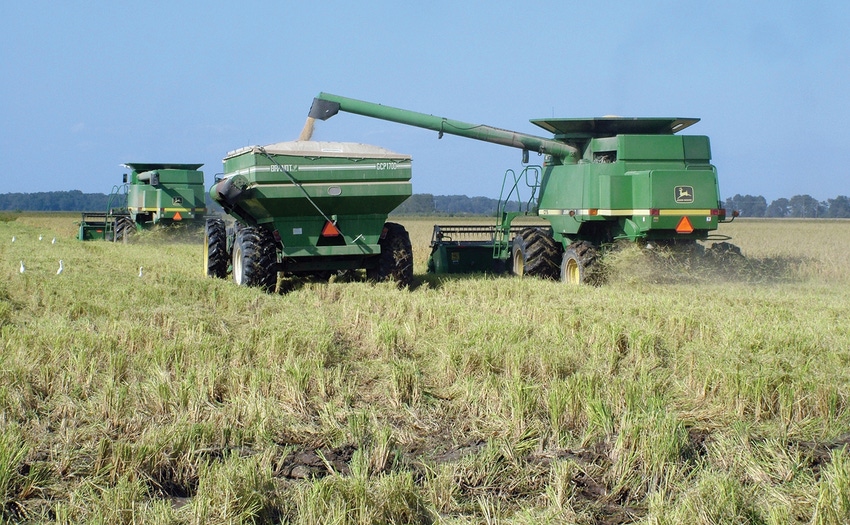June 5, 2018

Capsule Overview – Near Term Expectations
Week Beginning June 4, 2018
Commodity Index, $CRB – Slowly base building process underway
Oil, $WTIC – Correcting excessive bullish price move, then higher
Cotton – Bullish
S&P 500 – Bullish, but likely consolidation period underway
Foreign Stock Markets – Varies by market, sideways consolidation or corrective period before moving higher, bottom-line: in the aggregate most markets are building a base to move higher
Soybeans – Sideways consolidation, support needs to hold at $9.80
Corn – Correction likely underway, support needs to hold at $3.91 to remain near term bullish
Wheat – Correction likely underway, pushing through and holding $5.80 would make a statement
Rice – Price weakness a function of demand and planting expectations
U.S. Dollar – Bullish for a period, corrective period needed not required
10-Year U.S. Treasury Yield – Defining a trading range 2.7 to 3.3
The Week Ahead June 4, 2018
10-Year US Treasury Yield: For the week of May 28, 2018 the 10-Year US Treasury had a nice pullback of 1.37-percent to 2.89-percent. This U.S. and global yield trend is very supportive of pension funds, individuals, and businesses dependent on a more normalized interest rate.
The 10-Year Treasury Yield is building a sideways trading range. For a multi-month period this market likely trades in an interest rate range of 3.3-percent on the upside and 2.7-percent on the downside.
Market participants are anticipating a Fed Fund Rate increase of .25-percent at the next Federal Reserve Open Market Committee (FOMC) meeting June 12-13, 2018 and another likely increase at their September 25-26, 2018 meeting. (Charts A1-A4)
Presently, I have no expectation of a rate increase at their December 2018 meeting. The Fed is positioning to maintain a balanced yield curve, given global economic dynamics, as the year progresses.
Global Governments and Central Banks continue positioning to prolong the business cycle for an extended period of 2 to 3-plus years.
U.S. Dollar Index: Bullish on European, emerging market and global uncertainties; a current corrective period desirable, not required.
With the dollar index presently at 94.17 (Charts A5-A8) and off its low of 88.15, the index is in a slow determined corrective grind to the upside.
The dollar has entered a possible 1, 2-plus month period of more strength than weakness with an upside potential target of 96 to 98 before returning to the dominate downside trend.
This is an extremely challenging market since the U.S. Dollar strength has negative economic consequences to frontier, emerging, and developing economies, so we will closely monitor this market and adjust our expectations accordingly.
S&P 500: Sideways consolidation before moving higher.
Prices need to hold above 2720 to regain momentum needed to retest previous highs of 2873. Prices falling through 2560 would be near term bearish, but market cleansing.
The trend in this market remains up, but one should anticipate an additional 1 to 2-plus months of potentially stronger corrective activity, so exercise caution. Just let price action provide guidance until stronger momentum is regained. Note the collection of attached Equity Charts A14 to A28.
NASDAQ Composite Index: Just let price action provide guidance and be an active risk manager. The trend in this market is up, but be respectful of the dynamics of this market.
This high visibility market where speculative interest, high frequency traders, passive investors, etc. dominate price action absorbs its energy and leadership from the likes of Facebook, Apple, Google, Amazon, Netflix, Microsoft, etc. These high tech giants will continue experiencing on-again and off-again headwinds on a number of different fronts extending beyond consumer privacy rights.
$WTIC Light Crude Oil: Correcting the overextended bullish price move before likely moving higher. The expectation of higher future oil prices will be a function of 2 to 3-plus years of global growth.
This is a market in need of an extended pullback; said differently this is a market out-of-balance with other global currency, bond, equity and commodity markets. It’s a market where rising prices are increasingly placing a drag or limiting global growth.
Is the demand for oil waning? Not hardly. The summer months are the strongest demand months for the oil sector and stimulus driven global growth is achieving its objective of maintaining global economic momentum and the demand for oil.
Major supply concern: The Venezuelan economic, social, and political crisis has their country and oil sector near collapse.
The current oil price correction is a time of opportunity as speculative and value investors scan not only the oil sector, but the commodity complex for speculative and value investments.
There are an interesting array of factors from fundamentals, to global policy drivers, to social, economic, political, and military uncertainties that keep this market at elevated levels and they do not appear to be losing their influence anytime soon.
CRB Commodity Index: “BULIDING BULLISH BASE” as ongoing global stimulus driven growth coupled with geopolitical concerns appear to be near term supportive of the commodity sector.
With ongoing global equities realigning with global currency, bond and commodity markets, near term the index needs to push through resistance at 205 (currently at 203.3). On the downside the CRB Index needs to hold support at 185, otherwise major across the board commodity weakness would likely emerge.
Video: Rice, Grains, Oilseeds, and Cotton, May 31, 2018
USDA’s 2018/19 U.S. and Global Forecasts for Rice, Grains, Oilseeds, and Cotton
Description: International Economist Rachel Trego presents the new 2018/19 forecasts that USDA published for the major grains, oilseeds, and cotton. The presentation will include U.S. production, use, and exports, as well as global trends and developments with key competitors and markets. In addition, Ms. Trego will highlight data and analysis resources available from USDA and accessible on the FAS website.
Bio: Rachel Trego is an international economist with the U.S. Department of Agriculture Foreign Agricultural Service. She is the team leader for food grains analysis within the Office of Global Analysis, responsible for analyzing the global wheat and rice markets and reporting on supply and demand and price information.
Video Link: https://www.uaex.edu/farm-ranch/economics-marketing/food-agribusiness-webinars/
Rice, Grain and Cotton Charts B1-B28 in Chart Book
Soybeans: Range bound and thrashing around is highly descriptive of this market.
Reality is this market has spent almost 4-months moving sideways without a bullish or bearish commitment, so we sit back and watch the price action.
Soybean prices closing above $10.80-per bushel and holding gives the node to the bullish outlook and prices closing below $9.80 per bushel gives the node to the bearish case and further price weakness to $9.47-per bushel and possible lower to $9.01.
Corn: Corrective price action likely underway given the major deceleration in momentum, but near term corn remains bullish as long as prices can hold $3.91-per bushel. Holding above $3.91-per bushel opens the door to a potential price move to its June 2016 high of $4.39-per bushel and a possible secondary target of $4.83-per bushel.
Corn ending the week-of June 4, 2018 below $3.91 per bushel opens the door to a possible decline to $3.64 per bushel.
Wheat: Corrective price action likely underway before prices move to $5.83-per bushel or higher.
Long Grain Rice: Price weakness emerging as market participants are sniffing out the potential of planted 2018 U.S. long grain rice acreage exceeding the acreage figure released in the March 29, 2018 USDA Planting Intentions Report. Without a new demand source then fundamentals will weigh heavy on this market.
Cotton: Cotton prices remain bullishly sideways to up with the objective of moving to and possibly through the 98-cent area.
Timely Rice Outlook Video:
Presenter: Dr. Nathan Childs, Agricultural Economist, USDA’s Economic Research Service
Description: Nathan Childs presents the first official USDA global and U.S. rice market forecasts for 2018/19, including calendar year 2019 world rice trade. For the U.S., production, use, trade, stocks and price forecasts are presented by class and for all rice. All rice country-specific and global supply and use forecasts will be presented as well, with an emphasis on major trading countries. The first forecasts for global trade for calendar 2019 will be presented. Factors driving these forecasts will be explained.
Link: https://www.uaex.edu/farm-ranch/economics-marketing/food-agribusiness-webinars/
UA Drone Webinar: What's the Buzz About Drones: The Do's & Don'ts, June 7, 10:00 a.m.
Title: What's the Buzz About Drones: The Do's & Don'ts
Date and Time: June 7, 2018 10:00 AM in Central Time (US and Canada)
Presenter: Dr. Jim Robbins, Professor and Extension Horticulture and Drone Specialist, University of Arkansas System Division of Agriculture
Description: This seminar will be a fast orientation to world of drones and how you can use them in your agricultural operation. This quick overview should help you decide how to approach this emerging technology to reduce the financial risk of adoption.
Bio: For the past 19 years Dr. Robbins has been an extension specialist in commercial ornamentals at the University of Arkansas System, Division of Agriculture. His role is to support all Green Industry businesses including garden centers, wholesale growers, and landscapers. His research focuses on critical issues for the nursery industry. Since 2010 his research & extension efforts have focused on the use of small unmanned aircraft systems (sUAS) in horticulture.
Registration Link: https://uaex.zoom.us/webinar/register/WN_ILxA67_fQBqvR4Gu70SnXw
Bobby Coats is a professor in the Department of Agricultural Economics and Agribusiness, University of Arkansas System, Division of Agriculture, Cooperative Extension Service. E-mail: [email protected].
Download Slide Show for charts and expanded details, Click Download Link
DISCLAIMER-FOR-EDUCATIONAL-PURPOSES-ONLY
About the Author(s)
You May Also Like






